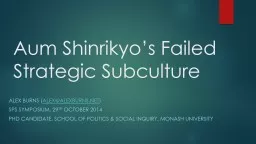

alexalexburnsnet Mid Candidature Review Panel 26 th October 2015 PhD Candidate School of Politics amp Social Inquiry Monash University Thesis Objectives To develop a midrange analytical theory of terrorist organisations as strategic subcultures ID: 681677
Download Presentation The PPT/PDF document "Mid Candidature Review Alex Burns (" is the property of its rightful owner. Permission is granted to download and print the materials on this web site for personal, non-commercial use only, and to display it on your personal computer provided you do not modify the materials and that you retain all copyright notices contained in the materials. By downloading content from our website, you accept the terms of this agreement.
Slide1
Mid Candidature Review
Alex Burns (
alex@alexburns.net
)
Mid Candidature Review Panel
, 26
th
October
2015
PhD Candidate, School of Politics & Social Inquiry, Monash UniversitySlide2
Thesis Objectives
To develop a mid-range analytical theory of terrorist organisations as strategic subcultures:
Synthesis of strategic culture and terrorist group / organisation literatures.
Identifies analytical variables, causal frameworks and mechanisms, and empirical / confirmation tests for theory-building
.
Initial step towards development of multi-level models.
Small-N study using process tracing in three case studies; and development of a database / codebook for future Large-N research.
Conceptualise
and develop the start of
an independent
research program.
Slide3
Progress Since Confirmation of Candidature
Dissemination of preliminary findings to International Studies Association’s 55
th
annual convention (27
th
March 2014) and East-West
Center
(16
th
October 2014).
Publication of co-authored article with Dr Ben Eltham in
Contemporary Security Policy
journal (
Scimago
Q2 ranking) and Routledge edited collection
Strategic Cultures and Security Policies in the Asia-Pacific
.
80,000 words of draft working notes written since Confirmation (130,000 words total + 270 additional pages of handwritten notes).
Clarification of process tracing methodology, case study criteria, data collection, and engagement with recent literature / discipline experts.
Feedback from Professor Jeffrey S.
Lantis
(Wooster College), Dr Alan Bloomfield (University of NSW), Professor Patrick Porter (University of Exeter) and other experts.
Research training in grant / tender preparation and institutional sign-off; contract negotiation; intellectual property rights; and business development.Slide4
Strategic Culture Defined: Jack Snyder
Formulated in 1977 by Jack Snyder for a RAND monograph on Ford and Carter administration détente and the Soviet Union
“Individuals are
socialized
into a distinctly Soviet mode of thinking . . .
a set of general beliefs, attitudes and
behavioral
patterns . . . that places them on the level of “culture” rather than mere “policy” . . .” [emphasis added] (Snyder 1977: v)“Culture is perpetuated not only by individuals but also by organizations.” (Snyder 1977: 9).“Strategic subculture: . . . a subsection of the broader strategic community . . . Reasonably distinct beliefs and attitudes.” (Snyder 1977: 10).Slide5
Terrorist Organisations
A terrorist organisation consists of the following elements:
Decision Elite
or
Senior Leadership
that is the organisation’s nucleus.
Violence Professionals
who carry out a Terrorist Campaign.Followers / Community of Support.Strategic Vision (ends) and a Violence Calculus (meta-ethical justification) to carry out a
Terrorist Campaign
(means) versus counterfactual alternatives.
Organisational Processes
such as fund-raising, recruitment, training, resource allocation, and target selection.
Assets
,
Resources
, and
Capabilities
.Slide6
Formal Definition of Terrorist Organisations as Strategic Subcultures
The collective behaviour, beliefs, norms, values, and worldviews that a terrorist organisation learns, uses, and culturally transmits in order to conduct terrorist campaigns as a ranked ordered strategic preference and violence calculus.
Meso
-level / mid-range level of analysis (group / organisation
).
Strategic subculture and confirmation tests.
Formal definition creates links to relevant literature in decision theory, preference formation, organisational adaptiveness / learning, and the psychology of cultural transmission.Slide7
Thesis Methodology
Small-N case study
using “heuristic” approach: existing literature versus strategic subculture explanations (George & Bennett 2005).
Selection of deviant and extreme cases (
Gerring
2012).
Process tracing
that identifies the causal mechanisms and processes that link X1 (terrorist organisation exists and rapidly grows) and Y1 outcome (survival over a significant time period and carries out successful terrorist campaigns) (George & Bennett 2005; Brun & Pedersen 2013; Bennett & Checkel 2015).Beginning of database / codebook for Large-N future research.Slide8
Causal Mechanisms
Social Learning
: acquired or imitated through the social interaction of individuals (or their artefacts and products).
Cultural transmission
: through-time diffusion of beliefs, lay theories, norms, values and worldviews as intersubjective knowledge.
Folklore
: myths, narratives, rituals, stories, symbols, and traditions as cross-cultural information structure.
Dr Alan Bloomfield’s doctoral research (2011) proposes other causal mechanisms including cognitive schemas and threat escalation.Slide9
Case Studies
Al Qaeda
: ‘Legend-making’ folklore around Osama bin Laden; Ali Mohamed and JFK Special Warfare Centre; Hamburg Cell compartmentalisation; and franchise strategy.
Aum
Shinrikyo
: ‘Failed’ strategic culture; Indo-Tibetan worldview; covert biological and chemical weapons research program.
Islamic State
: Rapid organisational growth; Caliphate strategic vision; and counter-response from United States and Russia (tests of national strategic cultures).Organisational Coherence, State Emulation, and Cultural Transmission tests.Slide10
Thesis Original Contributions
Spectrum framework
for strategic culture literature: attempts to build
Lakatosian
research program and case based reasoning.
Development of
classification
and empirical tests to identify terrorist organisations that have strategic subcultures.Causal mechanism testing and case study analysis.Preliminary Findings discussed in Mid Candidature Review documentation including intelligence analyst / national security policymaker relevance.
Future research
to develop multi-level models; ensemble / mixed methods; and examine strategic subcultures in international political economy / sociology of finance sub-fields.Slide11
Discussion